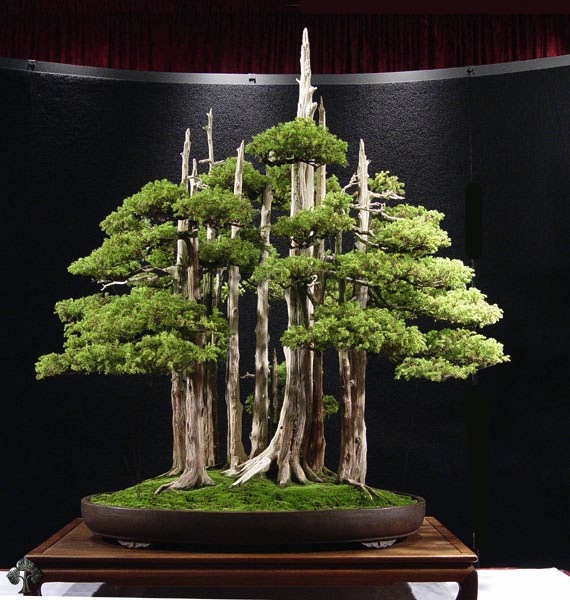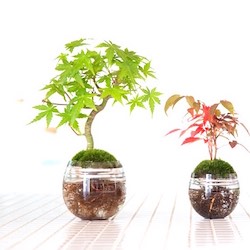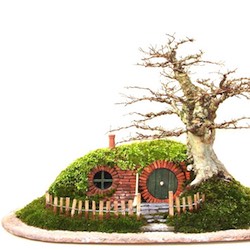John Naka
John Naka was born on the 16th of August, 1914. He passed away on the 19th of May, 2004. At the age of 8 he moved back to his parents' home country, where he extensively studied the art of Bonsai due to his grandfather's influence.
 He returned to the United States near Boulder, Colorado in 1935, and then in late 1946 settled in Los Angeles, California. In Orange County, Naka and four friends founded a Bonsai club in November, 1950, which is known today as the California Bonsai Society. He became a very important force in American Bonsai art in the 1950s-60s. He was a driving force in the spread of Bonsai appreciation and the practice of Bonsai art in the West and elsewhere. Naka traveled and taught extensively around the world, at conventions and clubs, but refused to hold classes in Japan (where Bonsai had been highly developed along certain lines over the centuries), saying "They want me to teach, and I tell them it's like trying to preach to Buddha."
He returned to the United States near Boulder, Colorado in 1935, and then in late 1946 settled in Los Angeles, California. In Orange County, Naka and four friends founded a Bonsai club in November, 1950, which is known today as the California Bonsai Society. He became a very important force in American Bonsai art in the 1950s-60s. He was a driving force in the spread of Bonsai appreciation and the practice of Bonsai art in the West and elsewhere. Naka traveled and taught extensively around the world, at conventions and clubs, but refused to hold classes in Japan (where Bonsai had been highly developed along certain lines over the centuries), saying "They want me to teach, and I tell them it's like trying to preach to Buddha."
Naka's masterpiece Goshin is on display at the United States National Arboretum.
(Info copyright; wikipedia)
Quick facts
Appeared at these events: N/A
Appeared in these magazines: N/A
Awards: numerous awards, including: The Fifth Class of the Order of the Rising Sun, National Heritage Fellowship, National Endowment for the Arts
Books: "Bonsai Techniques I", "Bonsai Techniques II", "Bonsai Techniques For Satsuki"
More information about John Naka
A very few of his many accomplishments are the following: He published two books, entitled Bonsai Techniques and Bonsai Techniques II, texts that are revered as being the bibles of western Bonsai to many artists. These books would be translated into French, German, Italian, and Spanish by 1990. He contributed articles, forewords, and photographs to a number of specialty magazines and books. In 1985, Emperor Hirohito of Japan bestowed upon Naka the most prestigious award for a non-Japanese citizen, The Fifth Class of the Order of the Rising Sun. Nina S. Ragle's compilation of 287 proverbs presented in both Japanese and English from Naka, Even Monkeys Fall Out of Trees, was published in 1987. (The title refers to the little recognized fact that, yes, even Bonsai masters can make a mistake.) He was a founding director of the World Bonsai Friendship Federation (WBFF) and a co-signer of the Constitution of the Latin-American Bonsai Federation (LABF). He was an honorary advisor to the National Bonsai Foundation. Naka was chosen in 1992 as one of thirteen honorees to receive a National Heritage Fellowship, the first Bonsai artist to receive this prestigious award. At the time he received his Fellowship, he said, "It has a beginning but no end. A bud today becomes a branch tomorrow.".
Other quotes of his included "Bonsai is not the result: that comes after. Your enjoyment is what is important"; "It must have philosophy, botany, artistry, human quality behind it to be a bonsai"; "The Bonsai is not you working on the tree; you have to have the tree work on you"; and "Leave room for the birds to fly through the branches of your bonsai".
Of Naka's many works, the most recognizable composition is Goshin, which means "protector of the spirit." It is a group planting of eleven foemina junipers, each tree placed to represent one of Naka's grandchildren. The planting can be seen on display at the National Arboretum. About a month before he died, Naka donated his very first bonsai, a Montezuma Cypress, to the National Bonsai and Penjing Museum. In May 2005, a collection of over 80 of his drawings of how he envisioned the future development of various workshop participants' trees was published as John Naka's Sketchbook, edited by Jack Billet and Cheryl Manning.
Goshin, a creation by John Naka
Some of John Naka's Bonsai trees

Goshin ("protector of the spirit") is a Bonsai created by John Y. Naka. It is a forest planting of eleven Foemina Junipers (each tree placed to represent one of John Naka's grandchildren), the earliest of which Naka began training into Bonsai in 1948. Naka donated it to the National Bonsai Foundation in 1984, to be displayed at the United States National Arboretum; it has been there ever since.

California Juniper

Montezuma Cypress (Taxodium Mucronatum)
Contact information
Location: N/A
Email: N/A
Website: N/A




